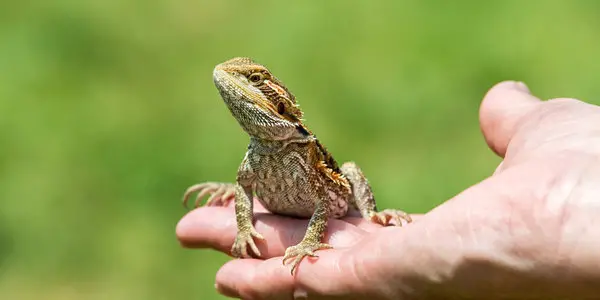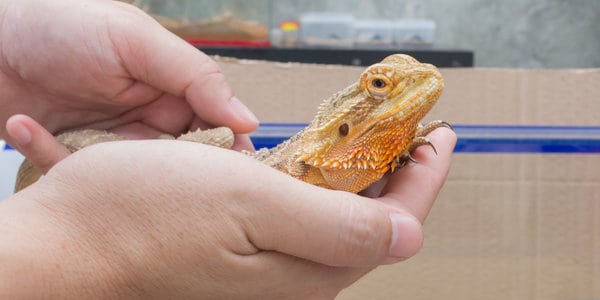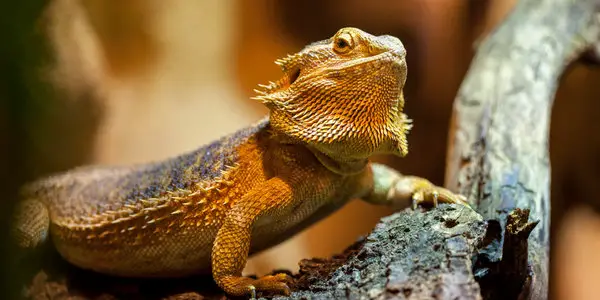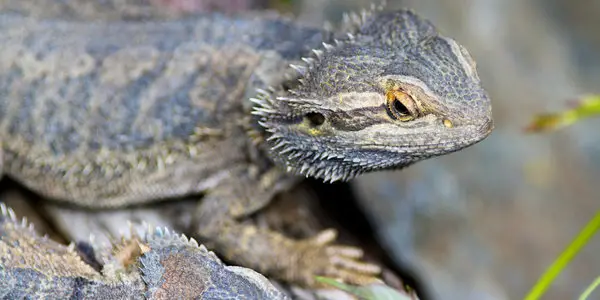If you own a dog, you may be wondering whether it’s possible to bring another pet like a bearded dragon, and the two graduate to become bosom friends.
So, the pertinent question is, do beardies and dogs get along? Yes, beardies and dogs can get along quite well.
However, they won’t show affection from the word go; they might initially show resentment. But once you make the right introduction, they will become placid and show signs of affection.
Don’t stop reading if you want to learn more about fostering a relationship between your bearded dragon and the dog in your compound.
This guide will cover everything from the safe introduction of these pets to the dangers of allowing them to interact.
Can My Dog and My Bearded Dragon Be Friends?
Though they seem incompatible, you’ll be surprised to learn that the two can actually be buddies. If you carefully, slowly, and steadily introduce your bearded dragon to your dog or vice versa, they can become best friends.
However, when introducing a bearded dragon to your dog, you should do your diligence on the safety precautions and the signs to watch during the introduction.
Since different animals may display different personalities, you should expect some signs of aggression and resentment in the first few meetings.
But you may still be surprised to find that your pets are docile and accommodative of each other.
Bearded dragons and dogs can establish a great relationship, but you need to watch them closely as they interact.
Beardies are inherently territorial and may get aggressive when a bigger animal is introduced. On the other hand, dogs are territorial and naughty hunters who may try to chase the smaller bearded dragon around.
Bearded dragons and dogs can easily get along if they are properly introduced and monitored closely.
If you still doubt that beardies and our canine friends can become the best of buddies, there are several videos on the internet of these pets playing without any problems.

Will My Dog Turn My Beardy Into A Snack?
It isn’t easy to predict whether your dog will eat your bearded dragon. Although some people claim that some dog breeds are more aggressive than others, it all depends on the personality and demeanor of the individual animal.
There’s no guarantee that your dog will be docile when it comes across a bearded dragon. For this reason, pet owners should assess the behavior of each animal individually and supervise all interactions.
When introducing animals from different species, there’s always a risk of not getting along in the first encounters.
Remember that how well your pets interact will depend on their upbringing. If your beardie and dog are healthy, well-bred, and have socialized with other animals in the past, the chances of them not getting along are slim.
However, pets that have spent most of their time living alone and haven’t had the opportunity to interact with other animals can find it challenging to socialize.
Although bearded dragons are not on the dog’s natural prey list, they might try to play with the lizard and injure them with their sharp and strong teeth.
Sometimes, they can even end up ingesting the beardie. Therefore, you must never leave the two animals unsupervised, especially if you own a bigger dog breed.
Are Bearded Dragons Afraid of Dogs?
Small animals will naturally feel frightened whenever they come across a bigger animal. So, it’s normal for your bearded dragon to be afraid of dogs, especially the large ones.
However, beardies can be desensitized to become accommodative to all types of pets.
In the same way that bearded dragons learn to socialize and interact with humans, they can be trained to interact with our canine friends.
As long as the introduction is done calmly and steadily, the bearded dragon will ease up and build rapport with dogs.
It’s common for a bearded dragon to be afraid of an animal with a more imposing figure. However, this doesn’t mean they won’t get accustomed to the animal being around.

How to Introduce Your Dog and Bearded Dragon Safely?
One of the recommendations, when you bring home a new bearded dragon is to keep it away from other species due to its territorial nature and love for a solitary lifestyle.
However, studies have shown that lizards can actually bond well with other domesticated pets, such as dogs, when introduced well.
While the differences in size between a dog and a bearded dragon can significantly impact how they behave during the introduction, proper preparation and continued patience can help them develop a formidable bond.
However, before you introduce a dog to a bearded dragon, make sure that you understand two things:
· Your Dog’s Mannerisms
Most canines tend to display volatile behavior when exposed to animals from different species.
However, since different dogs may have different reactions to different circumstances, you should know your canine’s varying temperament before taking it in front of a bearded dragon.
If your dog reacts violently when it sees a chameleon, frog, or other small animals, there’s a high possibility that it will react the same when it comes into contact with a bearded dragon.
You should be able to predict how your canine friend might react when it sees the dragon for the first time.
· The Risks Involved
The difference in size means that it’s easy for your bearded dragon to get hurt, even when playing with the dog.
So, before you decide to let the two animals become friends, you should know that one of the animals might get injured.
A quick search online reveals that several bearded dragons end up with severe injuries or even die when trying to play with dogs.
If you don’t have time to supervise the interaction between your dog and bearded dragon, you should never let them come into contact.
5 Helpful Tips to Introduce Your Dog to a Bearded Dragon
Follow these five steps when introducing your dog to a bearded dragon:
1. Find a Neutral, Quiet, and Isolated Ground
Dogs and bearded dragons are territorial creatures that enjoy commanding their own space. Therefore, pet owners should avoid introducing a dog to a bearded dragon when they are still in their territory.
Introducing a foreign creature into another animal’s territory will make them agitated and frightened, leading to aggressiveness.
The best approach is to take the animals to a neutral place. Choose a space that the dog doesn’t regularly visit, such as the office or study room.
The area should be quiet and away from other disturbances like buzzing television or movements by other pets.
Additionally, the bearded dragon should also be new to your chosen territory for the introduction.
You should continue taking the two animals to the neutral ground until you’re sure that your dog has now familiarized with the bearded dragon.
2. Find Someone to Help You
Introducing your dog to your bearded dragon is a two-person job. You’ll need someone else to hold the dog as you hold the bearded dragon during their first days or weeks of interaction.
Usually, it’s always prudent to use a family member since they’ll already have a great relationship with your dog.
The dog should be let loose on the leash, but if it reacts aggressively, it should be restrained to ensure that it doesn’t injure your beardie.
The leash should allow the dog to move freely, as being restricted will make it feel stressed.
Make sure you don’t let any of the animals free during the first days of interaction as they might display some negative reactions and even hurt each other.
Most experts recommend transferring the bearded dragon to a neutral ground while still in its cage.
The cage should be placed in an elevated location so that the dog can see the beardie but won’t be able to touch its terrarium.
In the initial weeks, you can keep the bearded dragon inside its container, but you should get it out when the two animals start to show friendship signs.
3. Don’t Overstimulate
Don’t overcomplicate the introduction processes by trying to overdo things for your pets. Avoid giving your bearded dragons unnecessary cuddles when meeting a new animal.
Conversely, don’t bring unfamiliar faces into the meeting room and avoid creating stressful situations like loud noises and sudden movements.
Considering that getting both the dog and bearded dragon to interact for the first time is challenging enough, any additional stimulation can make the experience more daunting and arouse aggressive and fearful behavior from the two pets.
Therefore, when introducing your dog to your bearded dragon, make sure that none of the animals is overexcited or uncomfortable. Ensure that:
- You don’t invite visitors to your home when doing the introduction
- There are no other animals around the area where the introduction is taking place
- No children are playing near the place where you’re introducing the pets, and avoid blasting off the music or making loud and distracting noises.
4. Never Leave the Pets Unsupervised
If you leave your dog and bearded dragon unattended, you’re putting them at risk. While the bearded dragon is the more vulnerable of the two, it can also hurt your dog.
Your canine friend is bigger, and thus, it can easily rough up and hurt your beardie, even if it’s just playing around.
Additionally, the beardie can easily get aggravated and bite the dog. Therefore, pet owners should ensure that interactions between the two animals are closely monitored and controlled.
Never leave a dog and a bearded dragon in the same room alone during the first days. They should only be left alone for a short period to see how they react, but only when they are getting along.
However, you should stay around and watch them so that you can respond quickly if they decide to become aggressive.
Remember, even pets that have stayed as buddies for years can still get aggressive and injure each other.
Sometimes, the pet’s behavior can change unexpectedly. For instance, male bearded dragons tend to become more aggressive during the mating season and can easily attack any animal around them.
They should never be allowed to interact with other animal species during this period.
5. Take Note of the Body Language
When introducing your canine friend to the beardie, keep an eye on its body language to understand whether they are happy or stressed.
Knowing how to read vital body signs will help you prevent your pets from getting into fights.
Check for these signs to know when your dog is stressed or hostile:
- A growling or lifted lip
- Long, intimidating stares
- Fierce barking trying to get to the bearded dragon
- Stiff muscles and unwavering posture.
If your dog displays these signs, you should try to calm it down.
An excellent way to calm down your dog is to give it a sweet treat in another environment or bring out its favorite toy. You can bring it back when it’s calm or wait until the next day.
Never punish your dog for being aggressive. Punishment increases aversion and fear and makes your dog easily prone to conflicts. When calm, your dog will sniff around, wag its tail and assume a loose, wiggly posture.
While bearded dragons are considered to be docile and calm, they may also exhibit aggressive and fearful behaviors when they spot a dog in their vicinity.
Some signs of fear, stress, and agitation in beardies include:
- Darkening of the beard
- Arm waving
- Hiding
- Head bobbing
- Long, unwavering stares
- Chasing
- Puffing up the beards
Although bearded dragons are not known to be aggressive towards larger animals, such as dogs, they might do so if they are scared or stressed.
If your bearded dragon has darkened its beard or is trying to hide when you bring a dog around, you need to understand that they feel frightened by the dog’s presence.
You should wait for them to come down or try to ease up their emotions by giving them sweet treats or a warm birth.
It’s expected that the dog and the bearded dragon may have a rough time getting along in the first days and weeks.
However, if you’re patient enough to allow the pets to learn good behavior and interact freely, you’ll be surprised to see them get along at some point.

Is It Okay for a Bearded Dragon to Chase after My Dog?
As depicted in most online videos, your beardie running after a dog is a typical playing style. This behavior shouldn’t be allowed when your pets have recently been introduced to each other.
It may be all jokes and fun, but if the dog deems the beardie as a nuisance, it can decide to defend itself.
Although the back and forth running happens with smaller dogs, a bearded dragon might decide to chase large skittish dogs and rescue dogs that are not used to such play.
They may injure the bearded dragon when defending themselves or just playing along. You need to monitor your dog’s behavior when a bearded dragon starts to chase it around.
If it seems relaxed and isn’t too harsh, you can let them play but be sure to keep an eye in case things get heated.
Risks and Dangers of Letting Your Dog Interact With Your Bearded Dragon
1. Possible Injuries
As a bearded dragon owner, you might think that you know the behaviors and temperament of your pets. But at the end of the day, pets are still animals, and their angry side may manifest when you least expect it.
Animals don’t have a true way of communicating their feelings to you. Therefore, you can’t know what they’re thinking, and allowing them to interact poses a risk of injury.
Bearded Dragon Injuries
While dogs don’t perceive bearded dragons as prey, their larger dispositions put the latter at risk. Dogs can bite your beardie when playing or even due to their aggressive nature. This is why all interactions between these two should be supervised.
Ensure that the bearded dragon remains in its enclosure during the first few days or weeks and keep the terrarium out of reach.
And even after the dog and the bearded dragon become friends, don’t leave your bearded dragon alone with your canine friend.
Once you limit in-person interactions in the initial days and always be present when your pets interact, you can lower the risk of your bearded dragon sustaining injury.
Dog Injuries
It’s not only the bearded dragon that’s likely to suffer an injury; the opposite can also happen, although not often.
When your bearded dragon is agitated and stressed by the dog’s presence within its vicinity, it can react by inflicting painful bites. Such bites can ooze blood and expose your dog to various infections.
You should know how to read your bearded dragon’s mood when bringing a dog around. If it seems a little agitated and frightened, try to calm it down or postpone the introduction until the next day.
2. Risk of Salmonella
Reptiles such as bearded dragons and turtles are known to be hosts for Salmonella. These creatures carry the bacteria in their gut, and it can easily be spread through their droppings.
When your dog has close interaction with your bearded dragon, it can ingest the salmonella bacteria and lead to gastronomical infection.
The worst part is the bacteria can be found on the lizard’s skin or the whole area where the beardie defecates have dispersed.
Our canine friends can get infected when they lick the bearded dragon or the contaminated area, eat its poop, or even when they ingest the beardie.
If your dog contracts the Salmonella infection, it will display these signs and symptoms.
- Diarrhea
- Lethargy
- Loss of appetite
- Fever
- Vomiting
- Nausea
- Headache
- Abdominal pains
These symptoms can last for even a week. You should visit the vet right away if you notice these signs in your dog after interacting with your bearded dragon.
If your dog doesn’t throw up after ingesting a bearded dragon, it can suffer from Salmonella poisoning, which can be fatal if not addressed immediately.
Bearded dragon owners should maintain cleanliness and hygiene in the bearded dragon enclosure. The tank should be cleaned regularly, and the lizard’s poop should be collected and disposed of safely.
Also, remember to wash your hand before and after handling a bearded dragon to avoid spreading Salmonella to your dog or your loved ones.
3. Risks of Parasites
Besides Salmonella, bearded dragons can also spread other parasites to your dog. If your beardie has been carrying parasites in its alimentary canal, they can come out with the fecal matter and spread across its enclosure.
When the dog touches the fecal matter, it can get the same parasites and suffer parasitic infections.
Some of the parasites in beardies might come from the feeder insects, and others may be caused by poor hygiene and a dirty tank.
You should ensure that your bearded dragon is regularly checked by a vet and assert that its terrarium stays clean.

My Dog Ate My Bearded Dragon’s Poop, Should I Be Worried?
Salmonella is the main concern when dogs ingest a bearded dragon’s poop. You should be concerned if your bearded dragon ate a sizeable chunk of the poop and when it starts to vomit. When it reaches a point where your dog is vomiting, you need to visit a qualified animal vet.
However, if your bearded dragon’s terrarium is always clean and healthy, your dog eating small dropping won’t pose any problem.
While dogs have a more robust digestive tract and immune system than humans, they shouldn’t be allowed to come into contact with bearded dragon defecates.
Which Pets Can You Keep With Bearded Dragons?
Most household pets will easily get along with bearded dragons. However, you should never bring your mouse close to your bearded dragon, as mice are lizard’s prey.
Still, these creatures can interact and create strong bonds with other pets such as cats, dogs, tortoises, and other types of lizards.
However, it’s critical to assert that the pet you want to introduce to your bearded dragon is healthy. Don’t introduce your beardie to a guinea pig, cat, or dog that is sick.
More importantly, you should avoid keeping bearded dragons in the same enclosure with other pets.
However, if you don’t have an alternative, you should keep beardies in the same enclosure with reptile species of the same size and from the same natural environment.
Since beardies are from the woodlands of Australia, they can be kept with tongue skinks, shingleback lizards, leopard tortoises, and spurred tortoises.
However, male bearded dragons should never be kept in the same terrarium with another male.
FAQs About Whether Bearded Dragons and Dogs Can Get Along
Are Bearded Dragons Good with Dogs?
When accorded ample time to familiarize with dogs, bearded dragons can be best friends with our canine friends. However, it’s crucial to ensure that the two pets are ready for companionship.
When you’re about to introduce them, you need to ensure that they are both healthy and in the right place in terms of behavior and temperament.
How Do You Introduce a Dog To a Bearded Dragon?
Introducing your dog to a bearded dragon can be daunting since it’s almost impossible to predict what will happen.
However, if you keep these useful tips in mind, you can introduce the pets without any hiccups:
- Don’t let the dog and the bearded dragon come into contact at first
- You need extra hands to help you hold the dog as you hold the bearded dragon
- Observe the pets’ body language to know whether they are comfortable or are feeling scared and agitated
- Never leave your dog and bearded dragon alone and unsupervised or unattended, even after years of interaction.
Can Bearded Dragons Hurt Dogs?
Because of the size difference, we’re always tempted to think that only dogs can injure bearded dragons. However, the opposite can also happen.
When bearded dragons are frightened or stressed, one of their knee-jack reactions is to fight. Bearded dragons can bite your canine friend leaving them exposed to infections.